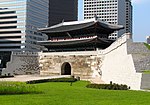2008 Namdaemun fire
2000s fires in Asia2000s in Seoul2008 crimes in South Korea2008 firesArson in South Korea ... and 9 more
Arson in the 2000sAttacks on buildings and structures in 2008Attacks on buildings and structures in AsiaBuilding and structure fires in South KoreaCrime in SeoulFebruary 2008 crimesFebruary 2008 events in South KoreaJung District, SeoulUse mdy dates from February 2018

On February 10, 2008, an arsonist set fire to the historic Namdaemun gate (officially "Sungnyemun") in Seoul, South Korea, causing severe damage to the 550-year-old structure. The monument was subsequently restored and reopened to the public in 2013.
Excerpt from the Wikipedia article 2008 Namdaemun fire (License: CC BY-SA 3.0, Authors, Images).2008 Namdaemun fire
Sejong-daero, Seoul
Geographical coordinates (GPS) Address Website Nearby Places Show on map
Geographical coordinates (GPS)
| Latitude | Longitude |
|---|---|
| N 37.559722222222 ° | E 126.97527777778 ° |
Address
숭례문 (남대문)
Sejong-daero 40
04512 Seoul
South Korea
Open on Google Maps








